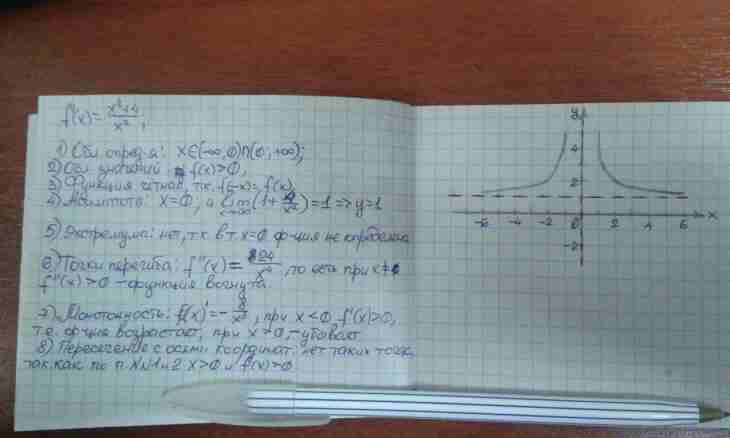Asymptotes are straight lines to which the function graph curve beyond all bounds approaches at aspiration of an argument of function infinity. Before starting creation of a function graph, it is necessary to find all vertical and inclined (horizontal) asymptotes if they exist.
Instruction
1. Find vertical asymptotes. Let the y=f (x) function be given. Find its range of definition and allocate all points of an in which this function is not defined. Count limits of lim (f(x)) when x aspires to a, to (a+0) or to (a−0). If at least one such limit is equal + ∞ (or - ∞), then direct x=a will be a vertical asymptote of a function graph of f (x). Having calculated two unilateral limits, you define as function at approach to an asymptote from different sides behaves.
2. Study several examples. Let y=1 function / (x²−1). Count lim limits (1 / (x²−1)) when x aspires to (1±0), (-1±0). Function has vertical asymptotes of x=1 and x=-1 as these limits are equal + ∞. Let y=cos function (1/x) be given. This function has no vertical asymptote of x=0 as area of change of function a cosine a piece [-1; +1] and its limit will never be equal ± ∞ at any values x.
3. Find inclined asymptotes now. For this purpose count k=lim limits (f (x) / x) and b=lim (f(x) −k×x) at x, aspiring to + ∞ (or - ∞). If they exist, then the inclined asymptote of a function graph of f (x) will be set by y=k×x+b straight line equation. If k=0, direct y=b is called a horizontal asymptote.
4. Review the following example for the best understanding. Let y=2×x− function (1/x) be given. Count lim limit (2×x− (1/x)) at x, aspiring to 0. This limit is equal ∞. That is direct x=0 will be a vertical asymptote of the y=2×x− function (1/x). Find coefficients of the equation of an inclined asymptote. For this purpose count k=lim limit ((2×x− (1/x)) / x=lim (2−(1/x²)) at x, aspiring to + ∞, that is k=2 turns out. And now count b=lim limit (2×x− (1/x) −k×x) = lim (2×x− (1/x) −2×x) =lim (-1/x) at x, aspiring to + ∞, that is b=0. Thus, the inclined asymptote of this function is set by y=2×x equation.
5. Pay attention that the asymptote can cross a curve. For example, for the y=x+e^ function (-x/3) ×sin (x) lim limit (x+e^ (-x/3) ×sin (x)) =1 at x, aspiring to ∞, and lim (x+e^ (-x/3) ×sin (x) −x) =0 at x, aspiring to ∞. That is direct y=x will be an asymptote. It crosses a function graph in several points, for example, in x=0 point.
